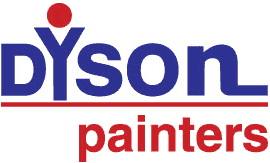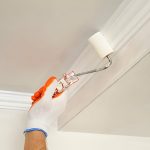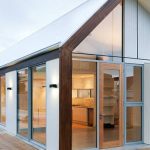If you’re a homeowner looking to paint your home, this guide for airless spray painting will make it easy for you to do it like a pro. Spray painting is a great way to get the job done quickly and with high quality. In this guide, we’ll give you essential tips and tricks to help you get the most out of this technique.
Top 9 Tips for Airless Spray Painting
#1: Safety First
Before diving into your painting project, prioritise safety. Airless spray painting involves high-pressure equipment and potentially harmful chemicals, so protective gear is non-negotiable. Wear a mask to protect your respiratory system from paint fumes, safety goggles to shield your eyes from overspray, and gloves to safeguard your hands from chemicals and paint. Safety should always come first to make your painting experience easy and safe.
#2: Choose Your Tip and Filter Size
One of the keys to achieving professional-quality results with spray painting is selecting the right tip and filter size for your project. The tip determines the spray pattern and size, while the filter prevents clogs and ensures a smooth flow of paint. Here’s a breakdown of the different filters to help you make an informed decision:
Mesh Filters
Mesh filters are commonly used in airless spray guns to strain paint and prevent debris from clogging the tip. They come in various mesh sizes, typically ranging from 30 to 100 mesh. A finer mesh size provides better filtration but may require more frequent cleaning. Consider the viscosity of your paint when selecting the mesh size, as thicker paints may require a coarser filter to prevent clogs.
HEA (High-Efficiency Airless) Filters
HEA filters are designed to maximise paint transfer efficiency while reducing overspray. They feature a proprietary design that optimises paint flow and minimises pressure fluctuations, resulting in a more consistent finish with less waste. HEA filters are particularly beneficial for large-scale projects or when working with high-viscosity paints.
Reversible Filters
Reversible filters are convenient for quick and easy cleaning during painting breaks or when switching colours. They can be reversed to flush out trapped debris and prevent clogs without disassembling the spray gun. These filters are ideal for homeowners who value efficiency and convenience without compromising quality.
Specialty Filters
In addition to standard mesh and HEA filters, some airless spray systems offer specialty filters tailored to specific painting applications. For example, fine finish filters are designed to deliver ultra-smooth results with low-viscosity paints, while tip filters are compatible with reversible tips for added versatility. Consider the unique requirements of your project when exploring specialty filter options.
Types of Filters Needed for Different Paint Types
When it comes to airless spray painting, using the right filter is crucial for achieving optimal results with different types of paint. Here’s a breakdown of the filters needed for specific paint varieties:
Lacquers
Lacquers are known for their smooth finish and fast drying time, making them a popular choice for furniture and cabinetry. When spraying lacquers, it’s essential to use a fine mesh filter with a high mesh count to ensure a flawless finish. A filter with a mesh size of 60 to 100 mesh is ideal for straining lacquers and preventing clogs in the spray gun.
Primer
Primer is the foundation for a successful paint job, providing adhesion and sealing porous surfaces. When applying primer with an airless spray gun, opt for a medium to coarse mesh filter with a mesh size of 30 to 60 mesh. This filter type effectively strains primer while allowing for smooth application and minimal overspray.
Emulsion and Exterior Paint
Emulsion and exterior paints are formulated to withstand the elements and provide long-lasting protection for interior and exterior surfaces. When spraying emulsion and exterior paint, choose a filter that balances filtration and flow rate. A medium mesh filter with a mesh size of 40 to 80 mesh is suitable for most emulsion and exterior paints, ensuring smooth coverage without sacrificing efficiency.
#3: Spray Test Onto Cardboard
Before diving into your airless spray painting project, take the time to perform a spray test on a piece of cardboard or scrap material. This allows you to adjust the spray gun settings and familiarise yourself with the spray pattern before applying paint to your intended surface. Adjust the pressure and nozzle settings to achieve the desired coverage and atomisation. Once satisfied with the results, you can proceed confidently, knowing that your spray gun is correctly calibrated for the task.
#4: Use Tip Extension for Extra Reach
A tip extension can be a game-changer when painting hard-to-reach areas or high ceilings. Tip extensions allow you to extend the reach of your spray gun, making it easier to coat surfaces without the need for ladders or scaffolding. Depending on the scale of your project, there are tip extensions available in lengths ranging from 15 to 60 centimetres. Choose the appropriate extension length to ensure maximum coverage and efficiency while maintaining optimal spray quality.
#5: Start with Corners and Edges
When tackling an airless spray painting project, working methodically to achieve a professional finish is essential. Start by spraying corners and edges and trim before moving on to larger surfaces. This allows you to establish clean lines and uniform coverage in areas that are typically more challenging to reach with a brush or roller. Focusing on corners and edges first ensures crisp, seamless transitions between different sections of your paint job, resulting in a polished result.
Tip #6: Start Moving Before Spraying
To prevent uneven coverage and drips, it’s essential to start moving the spray gun before engaging the trigger. This technique helps establish a smooth flow of paint and ensures an even distribution across the surface. Begin by positioning the gun slightly away from the surface, then gradually move it steadily while simultaneously activating the trigger. By starting your movement before spraying, you can avoid paint buildup and achieve consistent results from the first stroke.
Tip #7: Spray at a Constant Speed
Maintaining a consistent speed while spraying is key to achieving uniform coverage and a professional finish. Whether you’re working on walls, ceilings, or furniture, strive to maintain a steady pace throughout the airless spray painting process. Avoid speeding up or slowing down, as this can lead to paint thickness and texture variations. Practice controlling the speed of your movements to ensure a smooth, even application of paint with every pass.
Tip #8: Overlap Each Stroke by 30% for Even Coverage
To ensure thorough coverage and prevent streaks or missed spots, it’s essential to overlap each spray stroke by approximately 30%. This overlapping technique helps blend adjacent passes of paint, creating a seamless finish without visible lines or gaps. As you move the spray gun across the surface, aim to overlap each stroke with the preceding one by one-third of its width. By following this guideline, you can easily achieve consistent coverage and professional results.
Tip #9: Spray at an Even Distance at Right Angles to the Surface
Maintaining a consistent distance between the spray gun and the surface is essential for achieving uniform coverage and avoiding uneven application. Aim to hold the spray gun at a distance of 6 to 12 inches from the surface, depending on the type of paint and desired coverage. Additionally, position the spray gun at the right angle to the surface to ensure optimal paint atomisation and distribution. You can achieve smooth, flawless results with airless spray painting by maintaining a steady distance and angle.
Avoid Hassle and Hire Airless Spray Painting Specialists
Are you tired of the stress and hassle that comes with doing your own airless spray painting projects? Look no further. At Dyson Painters, our professional painting services can transform your space with ease and efficiency. We have the skills, knowledge, and top-of-the-line equipment to handle every aspect of the painting process, from surface preparation to final touches, ensuring a flawless finish that exceeds your expectations. By hiring our expert painters in Hobart, you can avoid the time-consuming prep work, messy cleanups, and uneven results that come with DIY painting projects.
We take pride in our meticulous attention to detail and commitment to quality craftsmanship, and you can rest assured that your project is in good hands. Whether you need to refresh a single room or give your entire home a new look, our specialists deliver outstanding results that stand the test of time.
Don’t let painting projects become a source of frustration and stress. Avoid the hassle and elevate your space with the help of our airless spray painting specialists. Contact us today at admin@dysonpainters.com.au or call us at 0420-213-214 to schedule a consultation and discover how professional expertise can make a difference!





